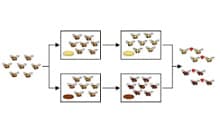In order to know the meaning of the term speciation, it is necessary, first of all, to know its etymological origin. Specifically, we can determine that it is a word that derives from Latin, since it is the result of the sum of the following lexical components:
-The noun “species”, which can be translated as “species”.
-The ending “-ar”, which is used to indicate verbal forms.
-The suffix “-cion”, which is used to indicate “action and effect”.
The notion of speciation is not part of the dictionary of the Royal Spanish Academy ( RAE ). The term, in any case, is frequently used within the framework of the theory of the evolution of species .
 Speciation, in this context, is a process that causes the population of one species to lead to the appearance of a different species . In billions of years, speciation greatly increased the diversity of organisms on planet Earth .
Speciation, in this context, is a process that causes the population of one species to lead to the appearance of a different species . In billions of years, speciation greatly increased the diversity of organisms on planet Earth .
At a general level, speciation is linked to the division of clades or cladogenesis . Through this process , an ancestral lineage ends up dividing into several sister lineages, which evolve independently. Therefore, after the initial bifurcation, the ancestral lineage becomes extinct and the sister lineages continue to develop in which speciation takes place.
Another mechanism that results in speciation is hybridization . In this case, two different species intersect and produce new individuals, whether or not they are fertile. Hybridization can develop naturally, although it is also carried out by humans artificially.
The most common type of speciation is allopatric or geographic speciation . In this case, a species is distributed over a very wide territory , with geographical barriers such as mountains and seas. The genetic pool of the species, in this way, is divided, establishing various isolated populations that evolve.
Peripatric speciation , parapatric speciation , sympatric speciation (also called sympatric speciation ), and quantum speciation (also called saltational speciation and instantaneous speciation ) are other types of speciation.
From the so-called parapatric speciation we can state that it is between sympatric and allopatric speciation. Likewise, we can emphasize that it consists of new species arising from what is the reproductive isolation of what are two biological subpopulations, being one next to the other and without there being any geographical barriers that could prevent what is happening. which is the flow of genes between them.
In addition to everything indicated, we cannot ignore what is known as chemical speciation. This term includes studies carried out on different physical-chemical species that are formed by an element in question and that are organized between several different phases.
Regarding this type of speciation mentioned lastly, we can also add that it is very useful when it comes to properly understanding everything from the different biogeochemical cycles to the chemistry of the elements that are analyzed in question.
